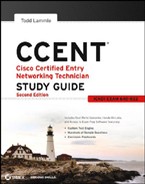Exam Essentials
Remember the steps to subnet in your head. Understand how IP addressing and subnetting work. First, determine your block size by using the 256-subnet mask math. Then count your subnets and determine the broadcast address of each subnet—it is always the number right before the next subnet. Your valid hosts are the numbers between the subnet address and the broadcast address.
Understand the various block sizes. This is an important part of understanding IP addressing and subnetting. The valid block sizes are always 4, 8, 16, 32, 64, 128, and so on. You can determine your block size by using the 256-subnet mask math.
Remember the four diagnostic steps. The four simple steps that Cisco recommends for troubleshooting are ping the loopback address, ping the NIC, ping the default gateway, and ping the remote device.
You must be able to find and fix an IP addressing problem. Once you go through the four troubleshooting steps that Cisco recommends, you must be able to determine the IP addressing problem by drawing out the network and finding the valid and invalid hosts addressed in your network.
Understand the troubleshooting tools that you can use from your host and a Cisco router. ping 127.0.0.1 tests your local IP stack. tracert is a Windows DOS command to track the path a packet takes through an internetwork to a destination. Cisco routers use the command traceroute, or just trace for short. Don't confuse the Windows and Cisco commands. Although they produce the same output, they don't work from the same prompts. ipconfig /all will display your PC network configuration from a command prompt, and arp -a (again from a DOS prompt) will display IP-to-MAC-address mapping on a Windows PC.
Understand basic NAT terminology. You must know the difference between inside local and inside global. This is mandatory! Inside local is before translation, and inside global is after translation. Inside global is defined as a registered address that represents an inside host to an outside network. You must also understand PAT and how it works by mapping multiple private IP addresses to a single registered IP address by using a different port number.
